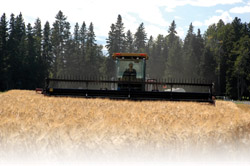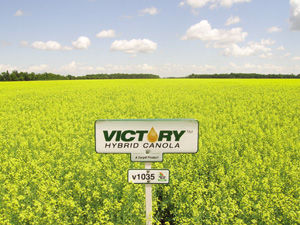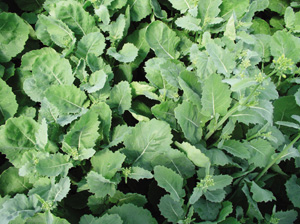
Features
Agronomy
Identity Preserved
Best management practices for producing specialty canolas
Ensuring identity and purity are main considerations.
March 5, 2008 By Donna Fleury
 |
| Rick Wiebe and growers at a Cargill Summer Tour, 2007. Photo Courtesy Of R. Wiebe, Cargill. |
As consumers become increasingly aware of the link between diet and health issues, they are demanding healthier alternatives in their food. One of their demands to end users is a switch to trans fat-free oils in restaurant and processed foods. That is good news for the canola industry, which has developed specialty canola varieties to meet those demands.
For growers, there are essentially no significant differences in agronomic management practices for producing a specialty canola as compared to a commodity canola crop. Growers who successfully grow commodity canola crops can use those same best practices to grow specialty canola. The more important consideration is to remember that specialty canola crops are produced under an identity preservation system, making the identity and purity of the specialty canola throughout the system the most important factor. Identity Preserved (IP) production is simply a method of segregating crops to ensure that the buyers get exactly the quality they need.
“End users are expecting a premium high quality oil, so companies selling specialty canolas and growers have to ensure they are supplying exactly what end users want,” explains Rick Wiebe, specialty canola supervisor with Cargill in Elm Creek, Manitoba. “End users rely on us to deliver a consistent supply of high quality oil, which we can do through an IP program.”
Tyler Groeneveld, Nexera canola marketing seeds and traits manager with Dow AgroSciences in Calgary, Alberta, agrees, noting that growing specialty canola is only unique in that a grower commits to a production contract, and manages the crop in an IP system to ensure no contamination with other commodity canolas. “Growing specialty canola is not very onerous for growers, with the exception of grain segregation in the bin, as long as they follow good agronomic practices. Growers need to understand that managing an IP crop such as Nexera canola does not mean much more management than they would expect from growing commodity canola.”
 |
| Tyler Groeneveld and Nexera canola harvest. Photo Courtesy Of Dow AgroSciences Canada. |
Following IP program requirements is very important to make sure the right variety is seeded, harvested, stored and delivered without any contamination or mix-up with other commodity varieties. Most of the time it is just common sense things that can get overlooked in the fast paced time of harvest, for example. “More often than not, the problems we run into are usually at the farm and with binning or sampling,” says Wiebe.
Harvest time is stressful and can be a challenge if different people are helping, making communications very important. “We send growers harvest sample packages that include bin tags for each bin,” says Wiebe. Bin tags are very important, as is ensuring harvest helpers understand the tags and do not mix specialty canola loads with commodity loads.
All harvesting equipment and bins should be emptied out completely before switching from a commodity canola to a specialty canola. Equipment does not require any special cleaning, but it is important to ensure that bins, trucks, augers and combine hoppers are empty before switching fields. “If a specialty canola and commodity canola crop end up being seeded beside each other, and the line between the two isn’t quite clear, then growers should consider harvesting the first swath of the specialty canola and bin it with their commodity canola to prevent any contamination,” says Wiebe.
Under the Cargill program, growers are expected to take a sample of every truckload going into the bin, which then becomes a representative sample for each bin. “Growers then submit a sample for every bin to our lab,” says Wiebe. “The results are turned around as quickly as possible and include a pre-grade assessment.” At delivery, each truckload or railcar is sampled before it is dumped at the crushing plant to ensure it is the right variety and meets the end users’ specifications. “If we can isolate any problems early on at the farm or before a load is dumped at the crushers, it solves a lot of potential problems.”
 |
| Victory v1035 hybrid canola in bloom, 2007. Photo Courtesy Of R. Wiebe, Cargill. |
From an agronomic standpoint, growers who are doing a good job of growing regular commodity canola will not have any issues with growing specialty canola. Wiebe explains that they have done some surveys with growers in the last couple of years comparing the actual fatty acid profile of their sample with the management practices they used on that field to get that sample. “At the end of the day, it’s the regular best management practices for canola production that are getting the results.”
Paying close attention to proper rotations, earlier seeding dates, good target plant populations, strong fertility program and proper harvest management practices are important. Make sure to empty seeding equipment from any other canola seed before seeding to avoid contamination. Seeding later or swathing too early can also result in too much green seed, which is detrimental to the quality of both specialty and commodity canola crops. A target plant population of seven to 14 plants per square foot is recommended for establishing a competitive crop early, and to minimize excessive branching that can result in uneven maturity. Even maturity can be important to the oil profile of the crop.
 |
| Early Nexera canola crop development, 2007. Photo Courtesy Of Dow AgroSciences Canada. |
“If a grower is really pushing a rotation and doesn’t do a good job of controlling volunteers, then he might find a volunteer problem in his specialty canola,” says Wiebe. Volunteer canola or wild mustard levels should be negligible in specialty canola crops to prevent potential oil contamination and losses in premiums. Keeping to the recommended three or four year rotations is a good management practice, and helps manage volunteers and weed problems. Growers now have specialty canola variety options in all three herbicide tolerant canola systems, which can be an effective management tool.
“As with any canola crops, it is important to know which herbicide system you are using, and ensure you are using the proper herbicide and following the label recommendations and rates,” says Groeneveld. “Our present Nexera canola is a Clearfield canola system, so growers need to ensure they are using the proper herbicide.” Nexera canola presents a good opportunity for growers as the program for Omega-9 canola oil grows in North America and around the world.
Cargill will have both Liberty Link and Roundup Ready hybrid canola varieties available for the 2008 growing season, giving growers a choice of growing hybrids in two different herbicide tolerant systems in their rotation. “Bayer has developed the InVigor Health hybrids with the Liberty Link technology exclusively for Cargill,” explains Wiebe. “We’ve also developed our Victory line of Roundup Ready hybrids internally.” Both the Victory and the InVigor Health hybrids produce the same specialty oil profile end-use customers desire.
As the demand for specialty oils continues to increase, growers may want to consider adding a specialty canola to their cropping system. Following an IP program to ensure the purity of the crop throughout the system, and implementing best management practices they are already using in growing commodity canola, are key. “Although specialty canola crops don’t require any different agronomic management, they are likely the highest value canola crop on the farm, and if any fields get a bit of extra attention the specialty canola will likely be the one,” says Wiebe. -end-